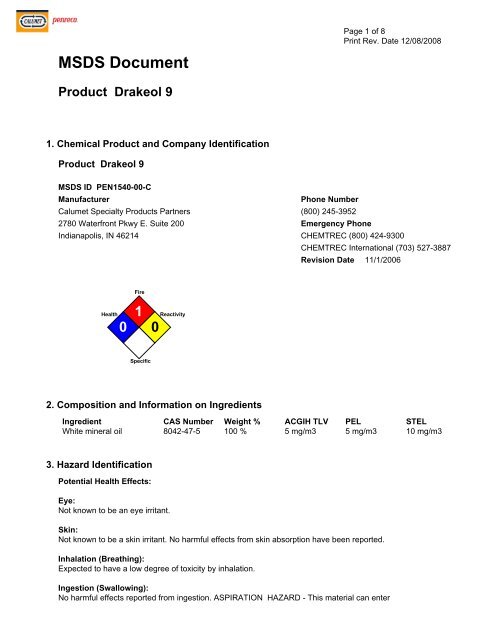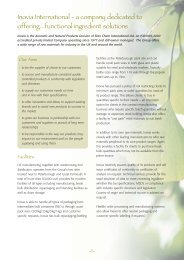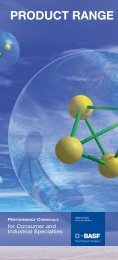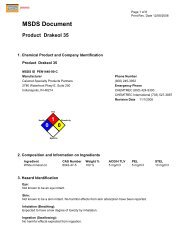MSDS Document Product Drakeol 9 - Holland Applied Technologies ...
MSDS Document Product Drakeol 9 - Holland Applied Technologies ...
MSDS Document Product Drakeol 9 - Holland Applied Technologies ...
Create successful ePaper yourself
Turn your PDF publications into a flip-book with our unique Google optimized e-Paper software.
<strong>MSDS</strong> <strong>Document</strong><br />
<strong>Product</strong> <strong>Drakeol</strong> 9<br />
1. Chemical <strong>Product</strong> and Company Identification<br />
<strong>Product</strong> <strong>Drakeol</strong> 9<br />
<strong>MSDS</strong> ID PEN1540-00-C<br />
Manufacturer<br />
Calumet Specialty <strong>Product</strong>s Partners<br />
2780 Waterfront Pkwy E. Suite 200<br />
Indianapolis, IN 46214<br />
Health<br />
0<br />
Fire<br />
1<br />
Specific<br />
0<br />
Reactivity<br />
2. Composition and Information on Ingredients<br />
Phone Number<br />
(800) 245-3952<br />
Emergency Phone<br />
Page 1 of 8<br />
Print Rev. Date 12/08/2008<br />
CHEMTREC (800) 424-9300<br />
CHEMTREC International (703) 527-3887<br />
Revision Date 11/1/2006<br />
Ingredient CAS Number Weight % ACGIH TLV PEL STEL<br />
White mineral oil 8042-47-5 100 % 5 mg/m3 5 mg/m3 10 mg/m3<br />
3. Hazard Identification<br />
Potential Health Effects:<br />
Eye:<br />
Not known to be an eye irritant.<br />
Skin:<br />
Not known to be a skin irritant. No harmful effects from skin absorption have been reported.<br />
Inhalation (Breathing):<br />
Expected to have a low degree of toxicity by inhalation.<br />
Ingestion (Swallowing):<br />
No harmful effects reported from ingestion. ASPIRATION HAZARD - This material can enter
lungs during swallowing or vomiting and cause lung inflammation and damage.<br />
Signs & Symptoms:<br />
Effects of overexposure may include irritation of the respiratory tract, irritation of the digestive<br />
tract, diarrhea.<br />
Cancer:<br />
No evidence of cancer has been demonstrated in several well conducted animal studies.<br />
Target Organs:<br />
No data available for this material.<br />
Reproductive/Developmental:<br />
No data available for this material.<br />
Health Hazards/Precautionary Measures:<br />
Aspiration hazard if swallowed. Can enter lungs and cause damage. Do not taste or swallow.<br />
Wash thoroughly after handling.<br />
Physical Hazards/Precautionary Measures:<br />
Keep away from all sources of ignition.<br />
4. First Aid Information<br />
Page 2 of 8<br />
Print Rev. Date 12/08/2008<br />
<strong>MSDS</strong> ID PEN1540-00-C<br />
<strong>Drakeol</strong> 9<br />
Eye:<br />
If irritation or redness develops from exposure, flush eyes with clean water. If symptoms persist,<br />
seek medical attention.<br />
Skin:<br />
First aid is not normally required. However, it is good practice to wash any chemical from the<br />
skin.<br />
Inhalation (Breathing):<br />
First aid is not normally required. If breathing difficulties develop, move victim away from<br />
source of exposure and into fresh air. Seek immediate medical attention.<br />
Ingestion (Swallowing):<br />
Aspiration hazard: Do not induce vomiting or give anything by mouth because this material<br />
can enter the lungs and cause severe lung damage. If victim is drowsy or unconscious and<br />
vomiting, place on the left side with the head down. If possible, do not leave victim<br />
unattended and observe closely for adequacy of breathing. Seek medical attention.<br />
Notes To Physician:<br />
Acute aspirations of large amounts of oil-laden material may produce a serious aspiration<br />
pneumonia. Patients who aspirate these oils should be followed for the development of longterm<br />
sequelae. Inhalation exposure to oil mists below current workplace exposure limits is<br />
unlikely to cause pulmonary abnormalities.<br />
5. Fire Fighting Measures<br />
Flash Point > 280°F /138 °C
FP Method COC, ASTM D92<br />
Flammable Properties:<br />
OSHA Flammability Class: Not applicable<br />
LEL (vol % in air): No data<br />
UEL (vol % in air): No data<br />
Autoignition Temperature: No data<br />
Unusual Fire & Explosion Hazards:<br />
This material may burn, but will not ignite readily. If container is not properly cooled, it can<br />
rupture in the heat of a fire. Vapors are heavier than air and can accumulate in low areas.<br />
Extinguishing Media:<br />
Dry chemical, carbon dioxide, foam, or water spray is recommended. Water or foam may<br />
cause frothing of materials heated above 212°F. Carbon dioxide can displace oxygen. Use<br />
caution when applying carbon dioxide in confined spaces.<br />
Fire Fighting Instructions:<br />
For fires beyond the incipient stage, emergency responders in the immediate hazard area<br />
should wear bunker gear. When the potential chemical hazard is unknown, in enclosed or<br />
confined spaces, or when explicitly required by DOT, a self contained breathing apparatus<br />
should be worn. In addition, wear other appropriate protective equipment as conditions<br />
warrant (see Section 8).<br />
Isolate immediate hazard area, keep unauthorized personnel out. Stop spill/release if it can<br />
be done with minimal risk. Move undamaged containers from immediate hazard area if it can<br />
be done with minimal risk.<br />
Water spray may be useful in minimizing or dispersing vapors and to protect personnel. Cool<br />
equipment exposed to fire with water, if it can be done with minimal risk. Avoid spreading<br />
burning liquid with water used for cooling purposes.<br />
6. Accidental Release Measures<br />
This material may burn, but will not ignite readily. Keep all sources of ignition away from spill/<br />
release.<br />
Page 3 of 8<br />
Print Rev. Date 12/08/2008<br />
<strong>MSDS</strong> ID PEN1540-00-C<br />
<strong>Drakeol</strong> 9<br />
Stay upwind and away from spill/release. Notify persons down wind of the spill/release, isolate<br />
immediate hazard area and keep unauthorized personnel out. Stop spill/release if it can be<br />
done with minimal risk. Wear appropriate protective equipment, including respiratory<br />
protection, as conditions warrant (see Section 8).<br />
Prevent spilled material from entering sewers, storm drains, other unauthorized drainage<br />
systems, and natural waterways. Dike far ahead of spill for later recovery or disposal. Spilled<br />
material may be absorbed into an appropriate absorbent material. Notify fire authorities and<br />
appropriate federal, state, and local agencies. Immediate cleanup of any spill is<br />
recommended.<br />
7. Handling and Storage<br />
Handling:<br />
Do not enter confined spaces such as tanks or pits without following proper entry procedures
such as ASTM D-4276 and 29CFR 1910.146. The use of appropriate respiratory protection is<br />
advised when concentrations exceed any established exposure limits (see Section 8).<br />
Do not wear contaminated clothing or shoes. Use good personal hygiene practices.<br />
Page 4 of 8<br />
Print Rev. Date 12/08/2008<br />
<strong>MSDS</strong> ID PEN1540-00-C<br />
<strong>Drakeol</strong> 9<br />
"Empty" containers retain residue and may be dangerous. Do not pressurize, cut, weld, braze,<br />
solder, drill, grind, or expose such containers to heat, flame, sparks, or other sources of ignition.<br />
They may explode and cause injury or death. "Empty" drums should be completely drained,<br />
properly bunged, and promptly shipped to the supplier or a drum reconditioner. All containers<br />
should be disposed of in an environmentally safe manner and in accordance with<br />
governmental regulations.<br />
Storage:<br />
Keep container(s) tightly closed. Use and store this material in cool, dry, well-ventilated areas<br />
away from heat and all sources of ignition. Store only in approved containers. Keep away<br />
from any incompatible material (see Section 10). Protect container(s) against physical<br />
damage.<br />
8. Exposure Controls and Personal Protection<br />
Engineering Controls:<br />
If current ventilation practices are not adequate to maintain airborne concentrations below<br />
the established exposure limits additional engineering controls may be required.<br />
Personal Protective Equipment (PPE):<br />
Respiratory:<br />
A NIOSH certified air purifying respirator with a Type 95 (R or P) particulate filter may be used<br />
under conditions where airborne concentrations are expected to exceed exposure limits.<br />
Protection provided by air purifying respirators is limited (see manufacturer's respirator<br />
selection guide). Use a NIOSH approved self-contained breathing apparatus (SCBA) or<br />
equivalent operated in a pressure demand or other positive pressure mode if there<br />
is potential for an uncontrolled release, exposure levels are not known, or any other<br />
circumstances where air purifying respirators may not provide adequate protection.<br />
A respiratory protection program that meets OSHA's 29 CFR 1910.134 and ANSI Z88.2<br />
requirements must be followed whenever workplace conditions warrant a respirator's use.<br />
Skin:<br />
Not required based on the hazards of the material. However, it is considered good practice to<br />
wear gloves when handling chemicals.<br />
Eye/Face:<br />
While contact with this material is not expected to cause irritation, the use of approved eye<br />
protection to safeguard against potential eye contact is considered good practice.<br />
Other Protective Equipment:<br />
A source of clean water should be available in the work area for flushing eyes and skin.<br />
Impervious clothing should be worn as needed.<br />
Suggestions for the use of specific protective materials are based on readily available
Page 5 of 8<br />
Print Rev. Date 12/08/2008<br />
<strong>MSDS</strong> ID PEN1540-00-C<br />
<strong>Drakeol</strong> 9<br />
published data. Users should check with specific manufacturers to confirm the performance of<br />
their products.<br />
9. Physical and Chemical Properties<br />
Physical State Liquid<br />
Specific Gravity 0.87<br />
Color/Appearance Transparent Water-white<br />
Odor None<br />
pH Not applicable<br />
Boiling/Cond. Point > 520°F / 271°C<br />
Melting/Freezing Point No data<br />
Solubility Negligible<br />
Evaporation Rate 1<br />
Vapor Pressure < 0.1<br />
Note:<br />
Unless otherwise stated, values are determined at 20°C (68°F) and 760 mm Hg (1 atm).<br />
Odor Threshold: No data<br />
Partition Coefficient (n-octanol/water) (Kow): No data<br />
Autoignition Temperature: No data<br />
Decomposition Temperature: No data<br />
10. Stability and Reactivity<br />
Stability:<br />
Stable under normal ambient and anticipated storage and handling conditions of<br />
temperature and pressure.<br />
Conditions To Avoid:<br />
Avoid high temperatures and all sources of ignition (see Sections 5 and 7).<br />
Materials To Avoid (Incompatible Materials):<br />
strong oxidizing agents.<br />
Hazardous Decomposition <strong>Product</strong>s:<br />
Combustion can yield carbon dioxide, carbon monoxide and other oxides.<br />
Hazardous Polymerization:<br />
Will not occur.<br />
11. Toxicological Information<br />
Chronic Data:<br />
No definitive information available on carcinogenicity, mutagenicity, target organ, or<br />
developmental toxicity.<br />
12. Ecological Information<br />
Not evaluated.
13. Disposal Considerations<br />
This material, if discarded as produced, is not a RCRA "listed" hazardous waste. However, it<br />
should be fully evaluated for hazardous waste characteristics prior to disposal (40 CFR 261).<br />
Use which results in chemical or physical change or contamination may subject it to<br />
regulation as a hazardous waste. Along with properly characterizing all waste materials,<br />
consult state and local regulations regarding the proper disposal of this material.<br />
Container contents should be completely used and containers should be emptied prior to<br />
discard. Container rinsate could be considered a RCRA hazardous waste and must be<br />
disposed of with care and in full compliance with federal, state and local regulations. Larger<br />
empty containers, such as drums, should be returned to the distributor or to a drum<br />
reconditioner. To assure proper disposal of smaller empty containers, consult with state and<br />
local regulations and disposal authorities.<br />
14. Transportation Information<br />
U.S. Department Of Transportation (DOT):<br />
Proper Shipping Name: Not classified as hazardous.<br />
Note: Material is unregulated unless shipped by land in a packaging having a capacity of 3,<br />
500 gallons or more. Then the provisions of 49 CFR, Part 130 apply.<br />
International Maritime Dangerous Goods (IMDG):<br />
Shipping Description: Not regulated<br />
International Civil Aviation Org. / International Air Transport Assoc. (ICAO/IAT<br />
Proper Shipping Name: Not regulated<br />
15. Regulatory Information<br />
U.S. Regulations:<br />
CERCLA/SARA - Section 311/312 (Title III Hazard Categories)<br />
Acute Health: No<br />
Chronic Health: No<br />
Fire Hazard: No<br />
Pressure Hazard: No<br />
Reactive Hazard: No<br />
CERCLA/SARA - Section 313 and 40 CFR 372:<br />
This material contains the following chemicals subject to the reporting requirements of SARA<br />
313 and 40 CFR 372:<br />
--None Known--<br />
EPA (CERCLA) Reportable Quantity (in pounds):<br />
--None Known--<br />
CERCLA/SARA - Section 302 Extremely Hazardous Substances and TPQs (in pounds):<br />
This material contains the following chemicals subject to the reporting requirements of SARA<br />
Page 6 of 8<br />
Print Rev. Date 12/08/2008<br />
<strong>MSDS</strong> ID PEN1540-00-C<br />
<strong>Drakeol</strong> 9
302 and 40 CFR 372:<br />
-- None Known --<br />
Page 7 of 8<br />
Print Rev. Date 12/08/2008<br />
<strong>MSDS</strong> ID PEN1540-00-C<br />
<strong>Drakeol</strong> 9<br />
California Proposition 65:<br />
Warning: This material may contain detectable quantities of the following chemicals, known<br />
to the State of California to cause cancer, birth defects or other reproductive harm, and which<br />
may be subject to the requirements of California Proposition 65 (CA<br />
Health & Safety Code Section 25249.5):<br />
-- None Known --<br />
Carcinogen Identification:<br />
This material has not been identified as a carcinogen by NTP, IARC, or OSHA. See Section<br />
11 for carcinogenicity information of individual components, if any.<br />
TSCA<br />
Hazardous Component(s) subject to reporting on the TSCA List.<br />
International Regulations:<br />
Canadian Regulations:<br />
This product has been classified in accordance with the hazard criteria of the Controlled<br />
<strong>Product</strong>s Regulations (CPR) and the <strong>MSDS</strong> contains all the information required by the CPR.<br />
Domestic Substances List:<br />
Listed<br />
WHMIS Hazard Class:<br />
Not Regulated<br />
International Inventories:<br />
Australia (AICS)<br />
Canada (DSL)<br />
China<br />
Europe (EINECS)<br />
Japan (ENCS)<br />
Korea (ECL)<br />
Philippines (PICCS)<br />
U.S. Export Control Classification Number:<br />
EAR99<br />
16. Other Information<br />
Intended Use:<br />
General White Oil<br />
From Section 2:<br />
ACGIH: OSHA: NIOSH: Other:<br />
5 mg/m3 TWA 5 mg/m3 TWA 2000 mg/m3 IDLH As Oil Mist, if<br />
10 mg/m3 STEL Generated<br />
2 mg/m3 TWA
As Paraffin Wax<br />
Fumes, If<br />
Generated<br />
5 mg/m3 NOHSC<br />
TWA<br />
Page 8 of 8<br />
Print Rev. Date 12/08/2008<br />
<strong>MSDS</strong> ID PEN1540-00-C<br />
<strong>Drakeol</strong> 9<br />
Note: State, local or other agencies or advisory groups may have established more stringent<br />
limits. Consult an industrial hygienist or similar professional, or your local agencies, for further<br />
information.<br />
1%=10,000 PPM.<br />
NE=Not Established<br />
Emergency Overview:<br />
24 Hour Emergency Telephone Numbers:<br />
Spill, Leak, Fire or Accident Call CHEMTREC:<br />
North America: (800) 424-9300<br />
Others: (703) 527-3887 (collect)<br />
California Poison Control System: (800) 356-3129<br />
Issue Date: 01-Nov-2006<br />
Previous Issue Date: 24-Jan-2006<br />
<strong>Product</strong> Code: 5040304<br />
Revised Sections or Basis for Revision: <strong>Product</strong> Name / Synonyms (Section 1)<br />
Physical Properties (Section 9)<br />
<strong>MSDS</strong> Code: 776510<br />
Disclaimer of Expressed & implied Warranties:<br />
The information presented in this Material Safety Data Sheet is based on data believed to be<br />
accurate as of the date this Material Safety Data Sheet was prepared. HOWEVER, NO<br />
WARRANTY OF MERCHANTABILITY, FITNESS FOR ANY PARTICULAR PURPOSE, OR ANY<br />
OTHER WARRANTY IS EXPRESSED OR IS TO BE IMPLIED REGARDING THE ACCURACY<br />
OR COMPLETENESS OF THE INFORMATION PROVIDED ABOVE, THE RESULTS TO BE<br />
OBTAINED FROM THE USE OF THIS INFORMATION OR THE PRODUCT, THE SAFETY OF<br />
THIS PRODUCT, OR THE HAZARDS RELATED TO ITS USE. No responsibility is assumed<br />
for any damage or injury resulting from abnormal use or from any failure to adhere to<br />
recommended practices. The information provided above, and the product, are furnished on<br />
the condition that the person receiving them shall make their own determination as to the<br />
suitability of the product for their particular purpose and on the condition that they assume<br />
the risk of their use. In addition, no authorization is given nor implied to practice any<br />
patented invention without a license.







